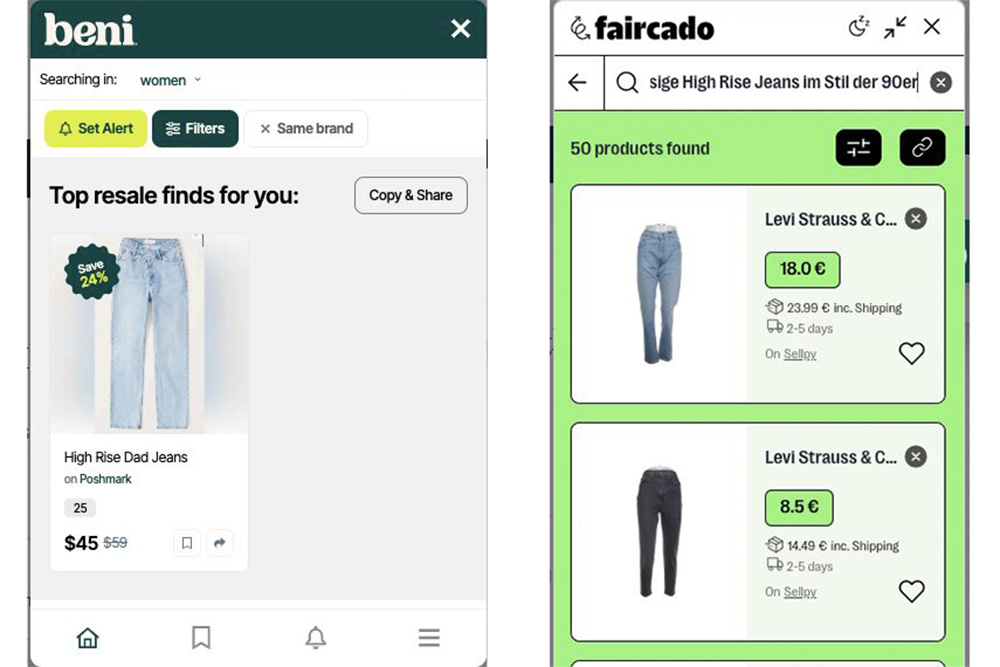You probably know by now that the fashion industry isn’t exactly kind to the planet. Producing the clothes we wear requires water and releases CO2 emissions. In the case of fast fashion brands looking to cut costs, the workers sew clothes for a low wage in unsafe conditions. When we’re finished with our clothes, they often end up in landfill in the Global South, while microplastics from polyester fabrics seep into rivers and oceans. Our desire for the latest trends leaves a whole lot of problems in its wake.
In recent years, so-called sustainable fashion has gone mainstream. It’s now on-trend to buy vintage and second-hand pieces—but there’s still plenty to be mindful of when shopping for ethical fashion. The following sustainable fashion apps and digital tools will help you avoid greenwashing brands and get the most out of your clothes.
The sustainable fashion apps helping reduce the fashion industry’s CO2 emissions
Apps that rate fashion brands on their sustainable practices
Want to check if your go-to fashion brand pays fair wages? Or if they’re really as green as their website claims? Sustainable ratings app Good On You shares information on thousands of fashion brands’ environmental and social impact. Similarly, COSH! (formerly Fairify) rates in-person stores across Belgium, the Netherlands, Spain and Germany.
Chrome extensions that show second-hand options
If you regularly shop for clothes online, try adding Chrome extensions Faircado or Beni to your browser. When you’re on a product’s page, it helpfully brings up second-hand outlets where the same (or similar) product is for sale. Berlin-based start-up Faircado works great in Germany (and is soon expanding to the UK), while Beni does the same in the US.
If everyone globally bought a second-hand item of clothing rather than a new one just once this year, it would save the same CO2 emissions as not driving 76 million cars for a day, according to ThredUp.
Apps to buy second-hand clothes
In the last decade, second-hand shopping has expanded beyond the charity shop and moved online. Now you can buy used clothes on peer-to-peer marketplaces such as eBay, Vinted and Depop. Alongside these big names, Poshmark and ThredUp are widely used in the US and Canada. And if you’re looking for designer pieces, try luxury-specific apps such as Vestiaire Collective or The RealReal.
Resale platforms run by fashion brands
Another option for shopping second-hand is to buy used rather than new from a specific fashion brand. Countless brands now have their own resale platforms, from Dr Martens to Patagonia. Run on resale-as-a-service software, these platforms are perfect for when you have a specific brand or product in mind but want to look for second-hand options.
While buying second-hand clothes online is undoubtedly better than purchasing new, emissions are still produced when shipping the items. Depop reports that 98 percent of its carbon footprint comes from users shipping parcels. Reducing your fashion consumption is still crucial when you’re purchasing used clothes.
Websites where you can swap locally
Swapping used clothes locally is free and doesn’t emit emissions via shipping. Look for clothes you like on local ‘free stuff’ Facebook groups or apps such as Communitique, which is currently growing from the US to Europe. Swedish start-up Popswap uses a Tinder-style swiping concept. Users upload items they want to swap and only match if they’ve both swiped right on each others’ items. Then they can meet up to arrange the swap. While it’s easy to get excited by free clothes, don’t convince yourself you like items just because you don’t have to pay for them. Being conscious about what you own means you’ll actually be excited to wear what’s in your wardrobe.
Borrow clothes with a rental app
Owning clothes just for a weekend is ideal for special occasion outfits you’ll only wear once. Countless apps offer rental with various subscription models. These include Nuuly, Armoire and designer-specific options such as Rent The Runway and My Wardrobe HQ.
Fix your clothes and dispose of them responsibly
Technology helping you repair your clothes
If your clothes are damaged, don’t make the bin your first port of call. There are plenty of apps that offer repair and restoration for your clothes, from The Seam to SOJO to Save Your Wardrobe to Repair Rebels. These apps are great for ease of use and introducing repair to a new audience. But a trip to your local tailors is still an ideal option and produces zero shipping emissions. Or, check out brand-specific repairs which are free when you buy a product from brands such as MUD Jeans, Boden and Toast.
Keep your clothes in the loop for as long as possible
Up to 30 percent of clothes donated to charity actually get resold. The rest are exported to the Global South where they negatively impact local economies and often end up in landfill. Avoid this by recycling your clothes responsibly. While there are digital tools that aid this process, they partner with fast fashion brands and encourage repurchase via discount codes, so we’d recommend avoiding them. Instead, check if the brand of the item of clothing has a take-back scheme. As more clothes integrate digital product passports, this information (or alternative recycling options) will be available in the item itself via a QR code. For now, a textile recycling bank will ensure your clothes find a second life.
The post Reduce the Impact of Your Wardrobe With These Sustainable Fashion Apps appeared first on Digital for Good | RESET.ORG.


